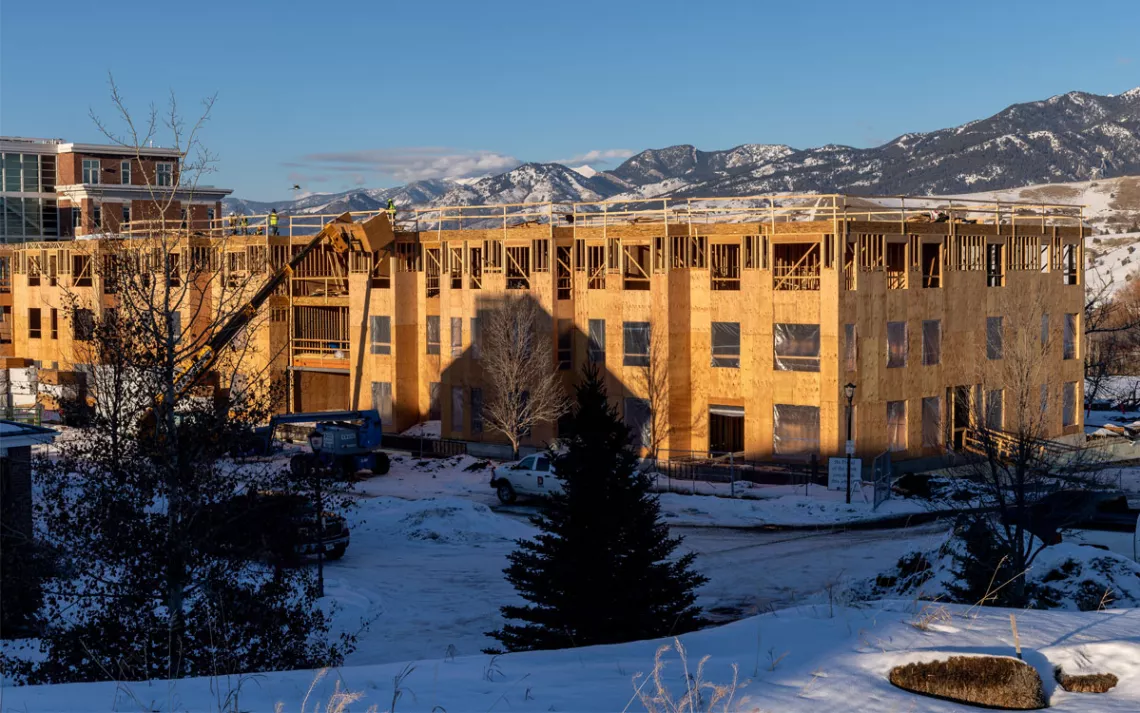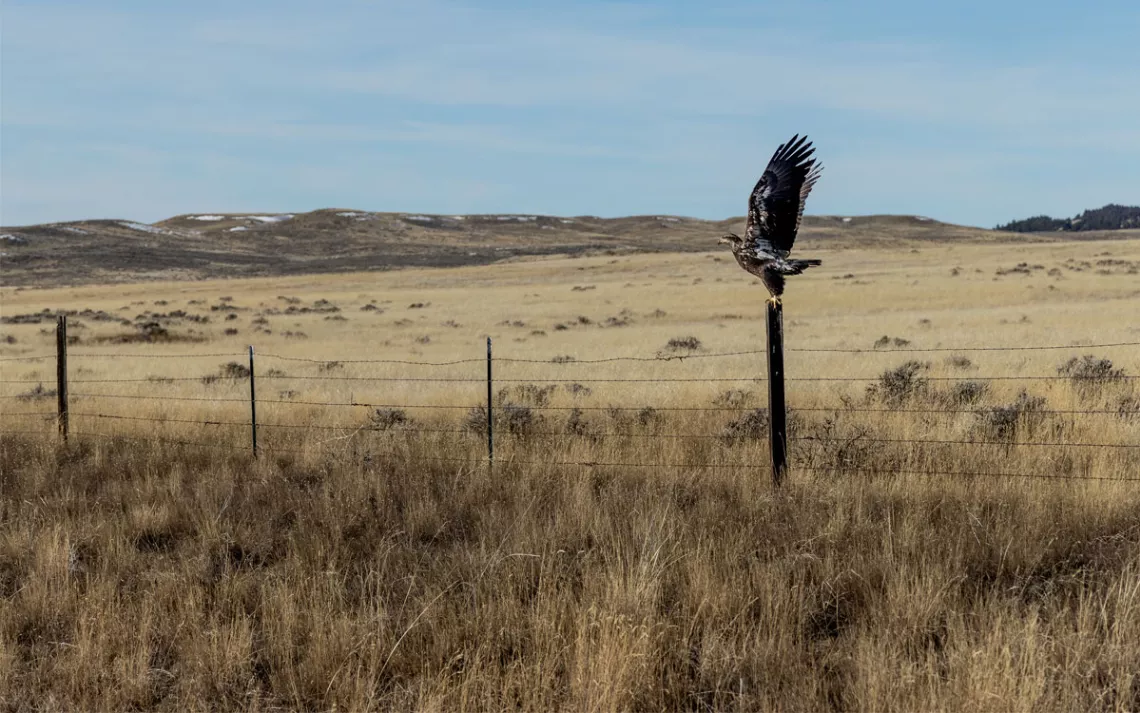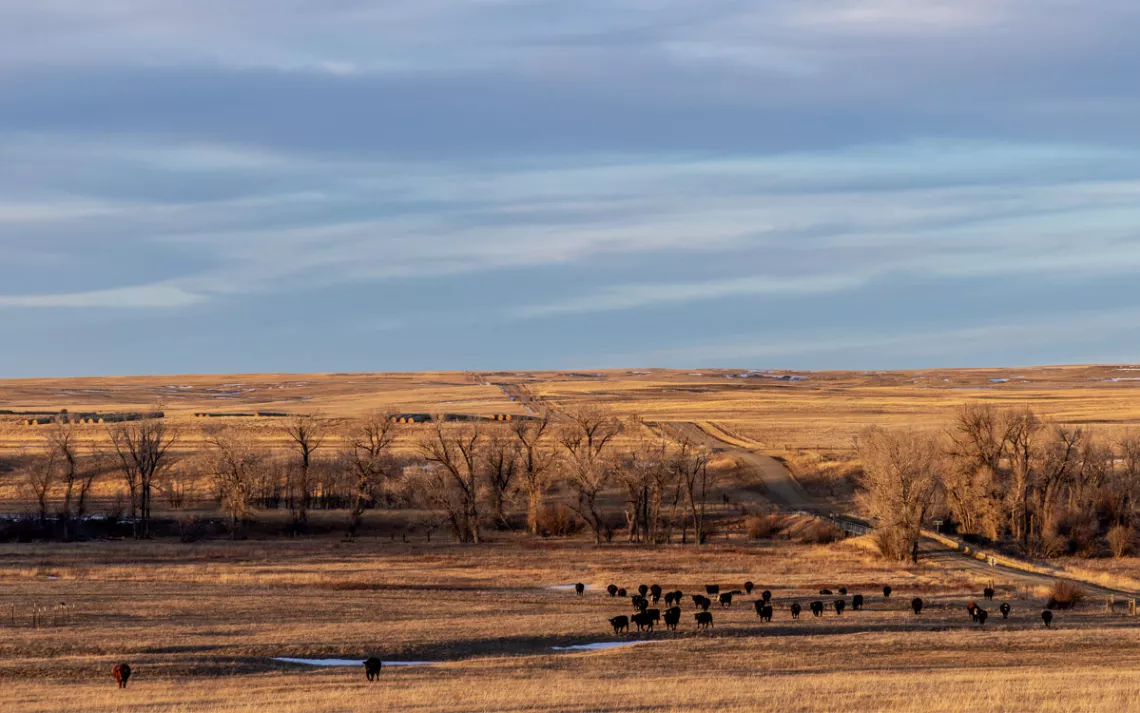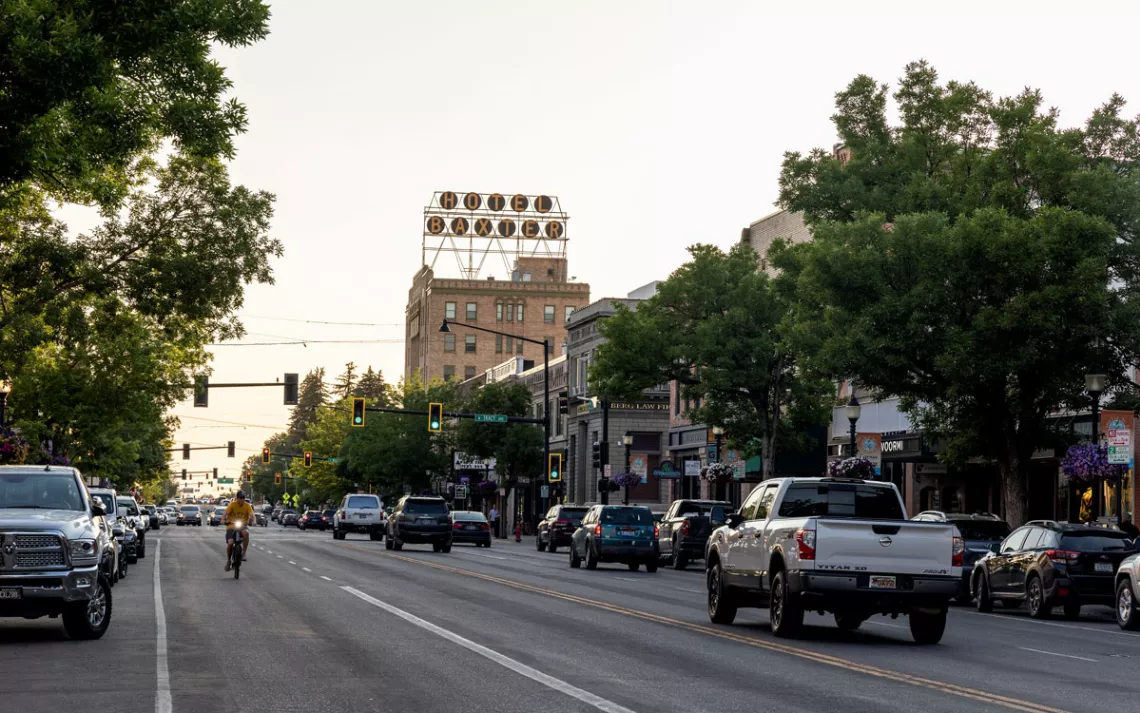Montana Has a Habitat Problem
Montana faces two crises. There's the housing for humans crisis. And there's the housing for everything else.

The area around a residential subdivision in Bozeman is parceled for further development.
NOT LONG AGO, an agricultural economist named Daniel Bigelow noticed something unusual happening in data collected by the USDA's Natural Resources Inventory. While it's still more lucrative for a well-located farmer or rancher to sell land to a housing developer than to actually produce food on it, Bigelow found that between 2000 and 2015, the rate of open space being converted to real estate annually dropped by nearly three-quarters. Construction on greenfields slowed to the point where about 7 million acres—half of them forestlands—that would have previously become subdivisions or strip malls remained undeveloped.
This had been accomplished with the help of an unexpected ally—high gas prices. "While there is no guarantee that the shifts documented here will be permanent," Bigelow's paper, published in Environmental Research Letters, concluded, "they have, at a minimum, provided more time for land conservation policy to be adopted."

A commercial building takes shape on the edge of downtown Bozeman.
At the time, Bigelow taught at Montana State University and lived in Bozeman, a small city on the edge of the Greater Yellowstone Ecosystem—over 3,000 square miles of private and public lands that make up one of the largest nearly intact temperate-zone ecosystems on Earth.
By the time Bigelow's paper was published though, the migration pattern was changing. Waves of remote workers relocated from cities to less populated areas during the pandemic—new residents who didn't need to worry about gas for commuting. Montana was one of those areas. In two years, the median price of a house in Bozeman nearly doubled. The crisis began to make national headlines, including one story about a local man who took to standing on a street corner with a cardboard sign, begging for the chance to buy a home. Bigelow himself was affected by Montana's housing prices. In July 2022, he moved out of state.
MONTANA FACES TWIN CRISES. There's the housing for humans crisis. And then there's the housing for everything else. The fourth-largest state holds critical habitats for some of the last free-ranging wildlife left in the Lower 48.

A bald eagle south of Roundup.
Elk, moose, wolves, and one of the few wild populations of grizzlies move through vast tracts of publicly owned forests. A male grizzly can range up to 830 square miles. A single adult elk eats 20 pounds of forage a day in the summer. Multiply that by 100 for a herd and suddenly Montana's vast valleys don't seem so endless. In winter, the animals trek out of deep snow to feed on grasses near the forest edge. They might find a new subdivision; those scenic, pine-scented areas attract development too.
Given the development pressures from the population surge, there's a real worry in Montana: The very thing drawing many here—open space—could become fragmented and destroyed.
As a fifth-generation Montanan, I wanted to better understand the growing pains at the edges of important agricultural and wilderness lands. I traveled around the state to see these crises firsthand.
WHEN I ASKED Velvet Phillips-Sullivan about her hopes for Whitefish, she answered that she wished she could still buy underwear there. The halcyon days of JCPenney multipacks are long gone. "You can get cheap tchotchkes or billion-dollar dresses, but you can't buy a freaking pair of underwear," Phillips-Sullivan said.
Whitefish sits on the edge of Glacier National Park, surrounded by beer-commercial mountains. It attracts an outdoorsy, wealthy demographic; I felt like I needed new REI gear just to drink an IPA at a local brewery. Even the Walgreens has a forest-green roof, wooden paneling, and a river-rock base—a Cabela's cabin-couture facade, just for three-in-one shampoo.
Decades ago, the little mountain town moved from logging to tourism, but until recently, the middle class could still afford to live there. Phillips-Sullivan grew up blue collar in a blue-collar Whitefish. As a single mom, she worked extra shifts at the locally beloved Buffalo Cafe to make rent. She became a reflexologist and eventually got involved in local politics.
Phillips-Sullivan was able to build the sort of home long pictured as the ideal across America: a single-family house with a large porch, garage, and yard. She's got a building for her reflexology business, Velvet Touch Reflexology—which she appreciates for bringing her into contact with new residents she might not have otherwise known. There, among crystals and essential oils, she works on the misaligned soles of well-heeled libertarians.

The sun sets over the prairie on ranchland near Melville.
Phillips-Sullivan and her husband have discussed moving. "We miss the old Montana," she said. The fourth-generation Montanan understood why Whitefish and Montana have become so popular. "Everyone wants their own private Idaho," she said, referencing the B-52s song that captures the corrupting allure of owning space.
A self-described "bleeding heart," Phillips-Sullivan said she cries over chopped-down cedars and the worry that rising energy prices will leave the old ladies of Whitefish eating cat food. When she sat on the city council 20 years ago, Phillips-Sullivan hesitated to approve new development in Whitefish. "Boy, I messed up," she said.
Her change of heart came recently, over a proposed development named Mountain Gateway. In Whitefish, most residents agree that there's a desperate need for less-expensive housing. Restaurants have cut hours because workers can't afford rent, even when making $20 an hour.
Where that housing will go is another question. Mountain Gateway would have consisted of 318 new units in apartment buildings and town houses, with around 30 units at below-market rates, as well as some commercial space. Public opposition to the proposal mounted, much of it from the area's wealthiest residents. A group of local billionaires threatened to pull their financial support for firefighters, food banks, and another low-income housing development.
Its location was key: Mountain Gateway would have sat near the ski resort. As for the housing development supported by the billionaires? Next to the sewage plant.
In the beginning, Phillips-Sullivan opposed Mountain Gateway. Her daughter changed her mind.
Mallory Phillips had recently returned to Whitefish from Idaho. She bought a house with her partner, Nathan Dugan. As housing prices shot up, she watched as friends were priced out of town. Phillips became a supporter of Mountain Gateway and yes-in-my-backyard (YIMBY) policies. Phillips-Sullivan witnessed her daughter transform from someone who was angry and full of grief about Montana to someone who was hopeful about its future. Phillips and Dugan got so involved in speaking out at Mountain Gateway meetings that they formed a nonprofit, Shelter WF.
Ultimately, the city council voted 5–1 against Mountain Gateway. Whitefish, which had previously made headlines for chasing white supremacist Richard Spencer out of town, had a new national story. The Forbes headline: "How Billionaires Helped Kill a Housing Development in a Montana Ski Town."

Vehicles cruise down Main Street in Bozeman.
The billionaires helped, but many others in Whitefish were against Mountain Gateway. The battle demonstrated something inherent to housing fights: It's much easier, and more compelling, to fight development. The costs are obvious: the addition of snarling traffic, the loss of a sunflower-filled vacant lot or charming old houses. Nearby residents worry about home values, given that's likely their biggest nest egg. And so public hearings fill with the opposition. Neighbors gather to stop a beloved place from changing.
But there's a fundamental problem with this dynamic: Future residents don't have the same political power as existing ones. And so construction is pushed outside the city limits or into less desirable areas, complete with a whiff of sewage. Prices continue to rise.
Late in the morning, I people-watched in downtown Whitefish. Trim thighs in yoga pants streamed by. Colors flickered between heather shades of cerulean and sage. There were bucket hats for function, bucket hats for fashion. My psychedelic '70s shirt received compliments and nervous smiles. The nearby coffee shop was helmed by a barista in a black button-up with zigzagging white circles. The shirt's owner and I exchanged the furtive, admiring glances that only happen between two people in loud shirts in a Patagonia town.
Downtown Whitefish had everything a prosperous lover of the great outdoors might desire. A real estate office advertised a 418-square-foot studio for $699,000 and a three-bedroom, four-bath house for $5.225 million. A store sold Fjällräven fanny packs and $50 T-shirts extolling local roots, printed in the USA and assembled in Nicaragua.
There, not far from the rainbow display of Birkenstocks, I found it. Phillips-Sullivan was half right. This wasn't the town of hardworking cotton underwear anymore. But just like you could still buy your own private Idaho for $5.225 million, and you could still build low-income housing so long as it neighbored the sewage plant, you could still buy underwear in Whitefish too: a $12 Free People lace thong.
BOZEMAN HAS BECOME the place that, for many Montanans, encapsulates everything that has gone wrong in the state. The once-dusty cowboy town is growing quickly. Bozeman's population has doubled in the past 30 years, to over 54,000. The city is a gateway to the Yellowstone Club, a gated golf and ski community that is the playground for the ultra-wealthy and famous, and to Yellowstone National Park, the playground for everyone else.
Over coffee, Bozeman's deputy mayor, Terry Cunningham, compared new development to a pitcher of water, and the table between us to the surrounding Gallatin County. Given the high housing demands, he could pour water all over the table, drowning out farmland and wildlife. Or, with smart policy and incentives, he could pour growth into a cup called Bozeman. Of course, that's easier said than done—or Bozeman would already be a tall glass of reasonably priced water.
Housing is a so-called wicked problem. There are many layers as to why it's gotten so expensive: land and material prices; labor shortages; aging sewers and crumbling streets; speculation; interest rates; long permitting reviews; short-term rentals like Airbnbs and VRBOs. But it's also true that vast swaths of Montana—like vast swaths of the United States—are zoned for single-family housing, a geographical legacy of racial and economic segregation that still keeps more affordable forms of housing from being built.
Sprawling suburbs and McMansions aren't just expensive; they eat up farmland and forests, put roads and truck traffic across wildlife corridors, and generate larger carbon footprints than housing built in urban areas. Still, in Bozeman, as in Whitefish, it's much easier to be a NIMBY toward denser housing. Cunningham said he "puts on his asbestos underwear" every time a dense development is proposed near single-family homes.
The problem has led to rare purple collaboration in a newly red Montana. Upzoning makes it possible to build duplexes and triplexes on single-family lots, tripling the number of people who could live there. By updating zoning regulations, local officials can avoid some of the contentious meetings that shut down infill development. In state task force meetings over housing, Missoula lefties and MAGA Republicans have found common ground on upzoning—and talking crap about Bozeman.
In one meeting, a conservative developer and member of the governor's task force on housing referred to Bozeman as a "gated community." Cunningham was incensed. The city has only a handful of tools for bringing down housing costs, he told me. In 2018, Bozeman began requiring developers building more than 10 units to either build a percentage for low-income buyers or to pay a fee—a practice known as inclusionary zoning. Low-income units slowly began coming through the pipeline. In 2019, Whitefish followed suit.
Then, in April 2021, Governor Greg Gianforte signed a bill that outlawed inclusionary zoning across the state. He also vetoed a bipartisan effort to provide tax credits for multifamily housing developments, citing in part the desire to see how deregulation could alleviate the market's problems.
"We aren't just sitting here, stuck in the mud," Cunningham told me about Bozeman's housing crisis. "At least our tires are spinning."
OF COURSE, Montana is not just Bozeman and Whitefish.
Some places across Montana aren't just avoiding a boom; they're losing population. During one state housing task force meeting, Terry Brockie of the Gros Ventre tribe listed the issues facing Eastern Montana in general and reservations in particular. A lack of housing, funds, developer interest, and infrastructure made zoning debates seem enviable and remote. "We'd like to get to some of these discussions someday," Brockie said.
Take Roundup, population 1,742. Cows were long gathered off the plains to be shipped there, and the round-up camp became Roundup after a few wranglers decided to hang up their hats. I followed their old journey through the southeastern Montana river country. That day, the sky seemed set on quantity over quality. The cloudless expanse highlighted how much of the Last Best Place remains open for steers and dusty-eyed cowgirls.
I met with Roundup's mayor, Sandra Jones, after hearing her at a governor's task force meeting making a plea for the group to come up with solutions that work for places like her town too. Jones reminded me of Leslie Knope from Parks and Recreation, if the famously industrious city employee were also an evangelical minister. Jones, with a light Tennessee accent, talked quickly and directly about how in her decade as mayor she'd found a new water source for Roundup and updated the zoning map. In a town where previous mayors had largely been figureheads and didn't even have a physical office, Jones was tackling some of the West's most contentious issues head-on.
Upzoning for density isn't controversial in Roundup, unlike in Whitefish and Bozeman, in part because developers aren't exactly lining up to build there. For now, investors seem focused on nearby Billings, and the greenfields outside it, given the lack of infrastructure in Roundup. Roundup's small tax base makes building new infrastructure difficult, and Jones pleaded with the state housing board to provide funds for new roads and storm gutters that could bring in development.
None of this is to say that Roundup isn't a beloved town or that there aren't more people who would move there if they could. Jones sent me down the road to a young resident who had returned after seeing the world. Morgan Belveal worked on educational programs to empower Ethiopian girls and at India's Sesame Street, a show called Galli Galli Sim Sim. When COVID hit, he was living in an apartment in Oakland, California, with his partner. The couple moved to Roundup, where Belveal bought his grandparents' business, the Big Sky Motel, and opened a barbecue restaurant that later got nominated for a James Beard award. Belveal and I talked on the restaurant patio so that he could keep an eye on the check-in desk in the event that anyone wandered in. From the Big Sky Motel, he has a front-row seat to Roundup's housing crisis. There's a lack of rentals—of the Big Sky's 22 rooms, around 12 are typically rented long-term to people who come for jobs in nursing or construction or to live in Roundup prior to building or buying. Belveal feels for his long-term residents: A room costs up to $2,700 a month, and living in a motel never feels like home.
He echoed Jones in saying that things move slowly in Roundup. "By the time you renovate something, something else collapses," he said. The lack of housing has contributed to a lack of young people in town. It's difficult for teachers or health-care workers to find homes and for families to find childcare. Belveal said that a "younger family" recently bought one of the bars, then remembered that the couple was actually his parents' age. It's not exactly Whitefish or Bozeman with their rushes of relocating young tech workers.
Belveal and his partner, Joey, field a lot of jokes from friends about Schitt's Creek—a TV show that follows a cosmopolitan family forced to live in a motel in a tiny rural town. Belveal said that Joey, who grew up in Baltimore, fits the type better. Belveal, a sixth-generation Roundup resident, knew what they were getting into.
Sometimes the pair dream of opening a steak house. In a town famous for being a cattle camp, Belveal said, it's impossible to get a good rib eye anymore.
WHENEVER I INTERVIEWED someone for this story, I asked what they did and didn't want Montana to look like in 20 years. Some answers revealed firsthand experience of sprawl and housing booms: Coloradans turned Montanans didn't want to see this place turned into Colorado. For others, the long-standing boogeyman of California was an easy answer. Mallory Phillips of Whitefish said that she just didn't want Montana to look like everywhere else.
When I asked what people hoped for Montana, no one named another state. Oregon wasn't held up as an example for upzoning; Texas didn't get a nod for its free market policies. Instead, people spoke of a Montana that was open-minded and neighborly. They spoke of vibrant, affordable cities and long, open horizons. They described intact ecosystems and family farms. Their vision for Montana looked a lot like Montana's past—just with more Montanans gracefully folded in.
I wrote much of this from the swaying expanse of my family's cattle ranch in Western Montana (its own complicated landscape, given its location on the traditional lands of the Salish and Kootenai). Rural subdivisions glittered across the river. In the 1980s, an old ranch family sold off and passed down slices of the mountainside. My father sat on the county land planning board and voted against turning the antelope habitat into houses. The subdivisions went forward anyway, and around 50 houses have sprouted up over my lifetime.
Given the lack of zoning and infrastructure, it's a bit of a Deadwood up there. Neighbors sue neighbors over road access and maintenance. Some residents have had to dig 400-foot water wells. If I were asked what I don't want Montana to look like in 20 years, I suppose I'd point to that carved-up, quarrelsome mountainside.
As the world gears up to deal with biodiversity loss and climate change, land conservation could hold important solutions for both. Gallatin Valley's rich farmland could sequester carbon; the lands surrounding Whitefish could remain critical open space for endangered species. Or, given its housing pressures and libertarian streak, Montana could sell itself off, slice by slice, to the highest bidder.
In order to avoid that, more Montanans need to reckon with what it means to live in, and protect, the Last Best Place. When I talked to Tracy Menuez, a community development director in Bozeman, she spoke about the inevitability of change. "Everyone I talk to feels like the community was perfect the day they moved here," she said. "I'm like, 'And it was perfect the day before you moved here too.'"
Montana—and the United States—has big decisions to make about how to change. We can choose to alleviate some of the wrongs of the past, the ones that contribute to sprawl, climate change, habitat loss, and economic and racial segregation. We can also choose to further entrench those wrongs.
That squares with an astrological prediction passed on to me by Phillips-Sullivan. I'm around the same age as her daughter. Phillips-Sullivan said that our generation would take one of two paths: "You guys are here to save the world or burn it down." According to the stars and Phillips-Sullivan, her generation will support us either way.
 The Magazine of The Sierra Club
The Magazine of The Sierra Club



